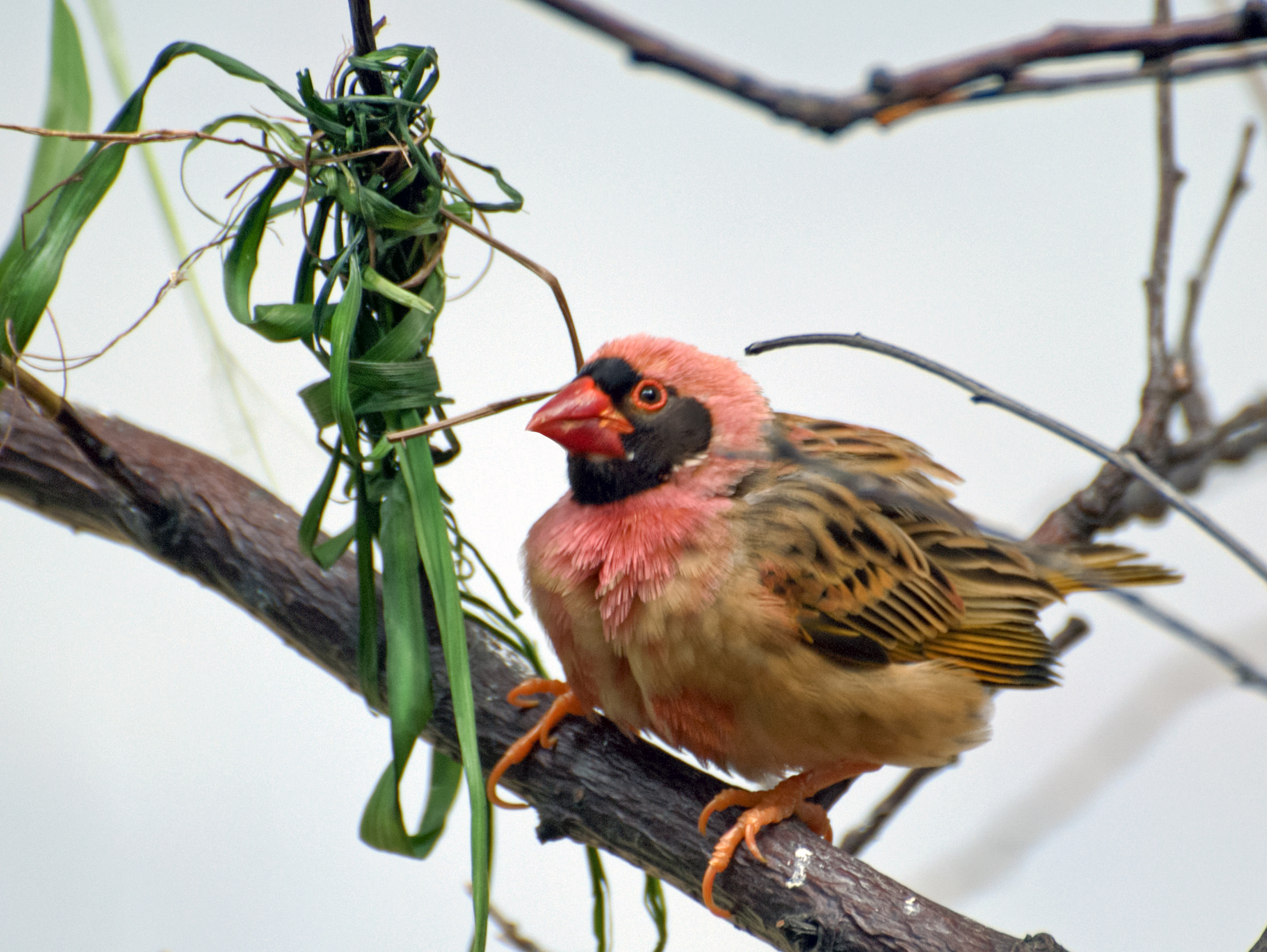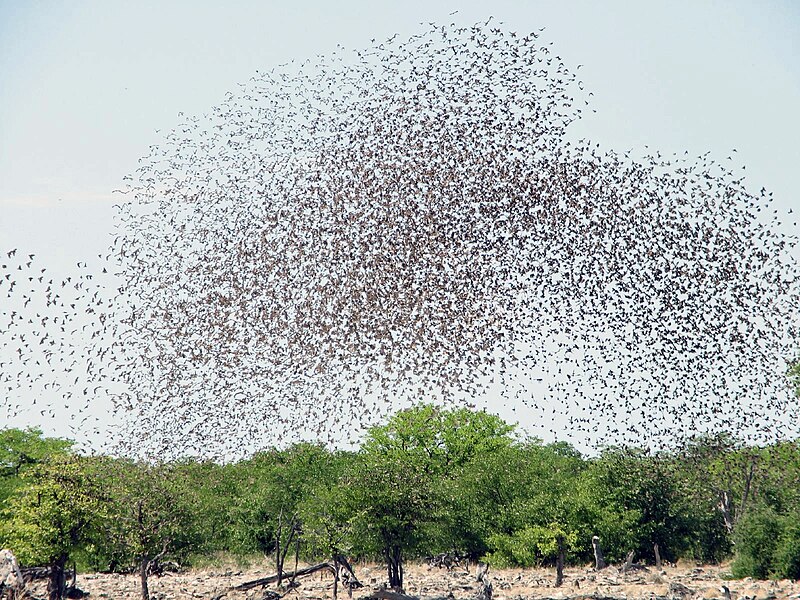 Although attracting less attention than European Starlings and other common birds, Red-Billed Queleas (Quelea quelea) outnumber them all. Yet despite being dubbed the “Locust Bird” for its habit of moving in flocks containing millions of individuals, this attractive African weaver is surprisingly difficult to breed in captivity.
Although attracting less attention than European Starlings and other common birds, Red-Billed Queleas (Quelea quelea) outnumber them all. Yet despite being dubbed the “Locust Bird” for its habit of moving in flocks containing millions of individuals, this attractive African weaver is surprisingly difficult to breed in captivity.
Description
Population size is not the Red-Billed Quelea’s sole unique characteristic. It is also the only bird in which males exhibit highly variable color patterns that are not designed to advertise their value as mates. In all other colorful, sexually-dimorphic species (those where males and females differ in appearance), color is used to express desirability to females (please see this Gouldian Finch article).
Some male Red-Billed Queleas vary so much from others that they appear to be of different species. The black or white facial mask is surrounded by feathers that may be colored red, orange, pink or various shades of each; the breast is often splashed with similar colors. Please see the article below for photos of several males…the effect of all this variation in a huge flock must be spectacular!
Ornithologists theorize that this characteristic may aid in individual recognition, but studies have not been conclusive; please see the article below for details.
Natural History
Queleas are classified the Family Ploceidae, which contains 4 sub-families – the True Weavers (Queleas), Buffalo Weavers, Parasitic Whydahs and Sparrows. Weavers are the avian world’s most accomplished nest-builders. Largely confined to Africa, weavers use complex knots to create enclosed nests that can only be entered from below. Positioned at the tips of tree branches, these unique nests discourage many predators.
The total Red-Billed Quelea population may approach 10 billion, with some flocks taking 5 hours to pass a single point! Amazingly, these huge aggregations move in a highly-synchronized fashion. Slow motion photography has revealed that the flock feeds in a rolling motion, and in doing so can deplete an area of seeds in short order (the video below pictures the largest gathering of birds ever caught on film).
Queleas prefer wild to cultivated plants, but are still considered to Africa’s leading grain-crop pest. The highly mobile flocks are tracked by agricultural authorities in South Africa and other countries.
Range
The Red-Billed Quelea is found throughout much of Sub-Saharan Africa, but is absent from heavily-forested and extremely arid regions. They are common in several popular wildlife reserves, including Kruger, Amboseli and Selous.
Habitat
 Queleas roam widely in search of grass seeds, their primary food, and also remain within flying distance of a water source. They may be found in savannas, thorn scrub, agricultural areas and wooded and marshy grasslands.
Queleas roam widely in search of grass seeds, their primary food, and also remain within flying distance of a water source. They may be found in savannas, thorn scrub, agricultural areas and wooded and marshy grasslands.
Captive Housing
Queleas are always on the move, and, being extremely gregarious, are not at ease unless kept in groups. Consequently, despite being a mere 5 inches in length, they are best suited to life in outdoor aviaries or indoor bird rooms.
Pampas and other stout grasses and shrubs planted in their aviary will make them feel at home and provide foraging opportunities. Those originating in the southern part of the range (3 subspecies have been identified) adapt well to cool temperatures, but they need shelter from damp and drafty conditions.
Diet
A high quality finch seed mix should form the basis of their diet.
Small crickets, mealworms, waxworms and canned and wild-caught insects should be offered year-round, and are a must for pairs with chicks. In outdoor aviaries, live plants can be used to attract caterpillars, grasshoppers and other tasty treats.
Fresh sprouts and egg food should also be a regular part of your Queleas’ diet.
Breeding
Weavers construct the most elaborately-woven nests of any bird…watching the construction process was one of the great delights of my time working with birds at the Bronx Zoo. Like most of their relatives, Queleas will use only long blades of green grass as a nesting material. Furthermore, they much prefer stripping these from living plants over picking them off the floor. Taveta Golden Weavers, Red Bishops and others I have kept exploded into action when I placed freshly-dug clumps of beach grass before them, but disdained grass clippings.
 Red-Billed Quelea pairs seem to exhibit mate fidelity (although I imagine it’s difficult for researchers – and perhaps the birds themselves – to keep track when 6,000 pairs are utilizing a single nesting tree!). They are stimulated to breed by rain, but also apparently need the company of others if they are to reproduce successfully.
Red-Billed Quelea pairs seem to exhibit mate fidelity (although I imagine it’s difficult for researchers – and perhaps the birds themselves – to keep track when 6,000 pairs are utilizing a single nesting tree!). They are stimulated to breed by rain, but also apparently need the company of others if they are to reproduce successfully.
Many other birds also refuse to reproduce unless surrounded by similarly-minded cohorts, a fact that has long thwarted captive breeding efforts. Some, such as the spectacular Cock-of-the-Rock, are known as “lek-breeders”…several males display together before a female. Spruce Grouse and others battle before waiting females to establish mating rights. Others, such as Queleas and flamingos, seem not to compete, yet will not breed in pairs or, sometimes, even small groups. I recall West Indian and Chilean Flamingos as being especially “fussy” during the breeding season. Even though I kept them in good-sixed flocks, I and my co-workers had to construct numerous mud nests before they “gave in” and began nesting themselves!
Unfortunately, aviculturists seem not to have hit on the right formula to induce regular breeding in the Red-Billed Quelea…ironic for a species whose flocks are often mistaken for smoke from massive grass fires!
Further Reading
Video: huge Quelea flock; the largest ever filmed
Photos: color variations in male Queleas
The Role of Color in the Red-Billed Quelea
Natural History of Queleas and other Weavers
Close up Quelea by Pawel Ryszawa (Own work) [GFDL (http://www.gnu.org/copyleft/fdl.html) or CC-BY-3.0 (http://creativecommons.org/licenses/by/3.0)], via Wikimedia Commons
Red-billed Queleas in Thorny Scrub by Frédéric SALEIN from Toulouse, France (Red-billed queleas Uploaded by Snowmanradio) [CC-BY-SA-2.0 (www.creativecommons.org/licenses/by-sa/2.0)], via Wikimedia Commons
Flock of Red Billed Quelea image referenced from wikipedia and originally posted by Alastair Rae
 That Bird Blog – Bird Care and History for Pet Birds
That Bird Blog – Bird Care and History for Pet Birds




Amazing. That video was incredible. Of course the passenger pigeon had many billions of birds, including one flock of an estimated 3.5 billion that took 14 hours to pass, and yet in a matter of decades we managed to exterminate them all. It boggles the mind.
Hello Amy
Nice to hear from you again…thanks. Yes, both numbers and the extinction re hard to believe!
Good luck, enjoy and please keep me posted.
Best regards, Frank Indiviglio.